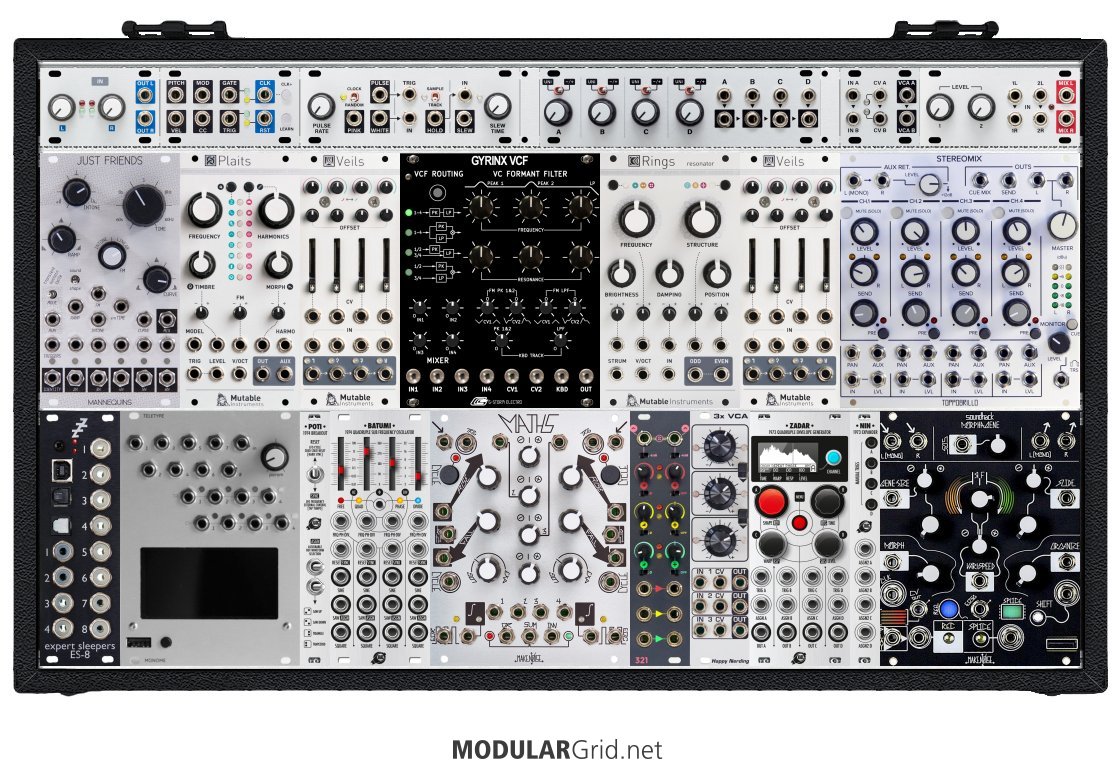I can see where this is headed, but without a lot more in the way of "helper" modules, this will be a total PITA to use. I'm also questioning the wisdom of having so many large-sized modules in a small cab, which is part of why you haven't got many of those "helpers" in the build, I would figure. But think...do you REALLY need four effects processors? Really?
Let's fix this....
OK...most of your main modules are still in there, but I got rid of the superfluous stuff, most notably the excessive amounts of effect processors. I kept the Morphagene because it's more than just a delay module and you appear to want a more granular approach to that aspect. But anyway...
TILES: Stereo input (for which you don't need extra jacks...the cab already has a pair for the input and the output as well), then the MIDI interface. Then I yanked the FX processor that was there because having a noise/random source is much more important, along with the other utilities there such as sample and hold and slewing. The Noise Tools tile can also serve as a master clock, but in this system that can probably be used for other purposes. QuadrATT is next, then I put in a Stereo VCA for a very specific reason related to the NEXT module, the Output Mixer. The VCAs are there so that, if you want to fly a signal in over the mix, you can have CV control over that level. So, if you want the Morphagene's output to slowly emerge from behind the dry signal...well, that's how you do it. And lots more besides.
MIDDLE: Just Friends and Plaits first. Then a Veils to sum down signals from those and control amplitude. Then the next thing...oh, it's just one of the most sought-after filters of all time: the Synton Syrinx, or G-Storm's clone of it. The Syrinx's filter was an elaborate and very expressive thing that was very formant-capable. G-Storm's version also has a 4-channel mono mixer on the input, so if you wanted to mix each preceding Veils channel through that, it's a snap. And after that, Rings...so you've got a formant-capable VCF (a VERY good match with the Just Friends, I should note!) going into a physically-modeled resonator. Sounds right to me! One more Veils after that, then I put in a Toppobrillo Stereomix2 as your performance mixer. This thing gives you CV over channel level, AUX level, and panning per channel. It's got a proper send/return for FX, also...mono out, stereo return, and you get a CUE, mute, and PFL too. Oh, and your headphone preamp there can be switched between the CUE and OUTPUT busses so that if you need to, say, correct tuning mid-set, you can put the offending VCO through the CUE to your headphones so that you can spot-up the tuning. In short...very effective.
BOTTOM: ES-8 and Monome thingy. Then Xaoc's Batumi (with Poti expander), Maths, and then the "modulation manipulation" bit, which uses a Frap 321 to wrangle more modulation out of the modulation and a Happy Nerding 3xVCA to control your modulation levels. Adding those to the modulation scheme actually results in being able to wring out a lot more of other derivative modulation signals. Then, Zadar/Nin...and the Morphagene.
So...this not only has its module complement fixed, the layout also makes far more sense by setting it up this way. Result will be that the rig will be easier/more intuitive to patch as the locations of different types of modules have been consolidated here. And with the "helpers" now in place, this will function far better than the initial build might've.

